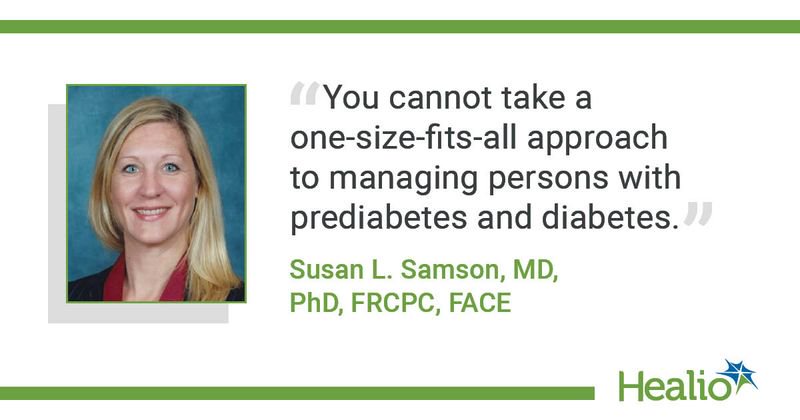Personalized approach emphasized in AACE consensus statement for treating type 2 diabetes
Click Here to Manage Email Alerts
Key takeaways:
- An AACE consensus statement and updated algorithms emphasize an individualized approach for treating type 2 diabetes.
- The statement details different therapy regimens for adults with CV comorbidities.
SEATTLE — Providers treating people with type 2 diabetes should take a complication-centric approach for determining first-line pharmacotherapy, according to a consensus statement.
An update to AACE’s Comprehensive Type 2 Diabetes Management Algorithm was published in Endocrine Practice and discussed during a plenary talk at the AACE Annual Scientific and Clinical Conference. The updated algorithm includes two sections that focus on complications-centric and glucose-centric approaches to glycemic control for people with type 2 diabetes.

“You cannot take a one-size-fits-all approach to managing persons with prediabetes and diabetes,” Susan L. Samson, MD, PhD, FRCPC, FACE, president-elect of AACE, chair of the division of endocrinology, diabetes and metabolism in the department of medicine at Mayo Clinic in Jacksonville, Florida, and an Endocrine Today Editorial told Healio. “You have to take a personalized, patient-specific approach, including lifestyle and weight management goals, the choice of medical therapies to treat glucose and their comorbidities, such as hypertension or dyslipidemia.”
Individualized pharmacotherapy with CV complications
Samson said the complications-centric approach was developed because a wider range of medications have become available for people with diabetes, giving providers a greater opportunity to individualize care.
“Over the past few years, we have learned that there are specific choices of medical therapies, such as for glucose control, that improve patients’ outcomes of complications from diabetes, including risk of stroke, CV events or progression of diabetic kidney disease,” Samson said. “You must consider, what is the best choice for your patient that can impact their long-term health and quality of life — and even their life expectancy?”
Irl B. Hirsch, MD, professor of medicine at the University of Washington School of Medicine in Seattle, discussed the new algorithms at the beginning of a plenary session. The complications-centric algorithm focuses on people with type 2 diabetes who also have atherosclerotic cardiovascular disease, heart failure, stroke or chronic kidney disease. For adults with atherosclerotic CVD, providers should start treatment with a GLP-1 receptor agonist or SGLT2 inhibitor. Those with heart failure should receive an SGLT2, whereas those with stroke should receive a GLP-1 or pioglitazone. Adults with CKD should begin therapy with an SGLT2 or GLP-1.
The glycemic target for adults with complications should be an HbA1c of 6.5% or less, or between 7% and 8% for those at risk for adverse consequences from hypoglycemia or with a limited life expectancy. If a patient does not reach their glycemic target within 3 months, providers should titrate to a maximum tolerated dose or add another agent.
Hirsch noted that the algorithm includes only HbA1c targets, but he said he believes that continuous glucose monitoring metrics may be used as targets in the future.
“My prediction, in the next 3 years, 5 years, is that these algorithms will not just look at HbA1c, but they will also look at time in range, also for people with type 2 diabetes not on insulin,” Hirsch said in a presentation. “It’s just a matter of time before that also becomes more of a standard of care.”
Treatment with glucose-centered approach
Patients who have no CV complications or those with CV complications who were unable to reach their glycemic target with the complications-centric approach should be treated using the glucose-centric algorithm. This approach starts lifestyle intervention, use of metformin if appropriate and an individualized HbA1c target that is similar to the complications-centric approach.
For medical therapy, those with overweight or obesity or people with a higher risk for hypoglycemia should receive a GLP-1 and glucose-dependent insulinotropic polypeptide (GIP)/GLP-1 dual agonist or an SGLT2. For adults with medication access or cost concerns, generic agents can be used.
“AACE has always presented the ideal scenario for management based on the evidence,” Samson told Healio. “However, in the U.S. and throughout the world, there are differences in the ability of patients to access certain medical therapies, so it was important to present additional possible management approaches for patients in this situation.”
Adults at risk for severe hypoglycemia should receive basal insulin plus prandial insulin, or a GLP-1 or GIP/GLP-1 therapy. The algorithm also provides alternative therapies and drugs that are not recommended for adults in each category.
As with the complication-centric algorithm, the glucose-centric algorithm recommends titration to the maximum tolerated dose at 3 months if the HbA1c target has not been reached. Providers can also add the best available agent that is not in use. If a target is still not reached, providers can consult another algorithm for adding or increasing insulin therapy.
“The point of all of this is that we now have a very specific strategy and it’s based on evidence,” Hirsch said during a presentation.
The paper also included other points of emphasis, including the need to incorporate medical therapies and bariatric surgery for weight loss in addition to lifestyle modification. Samson said this was a focus due to the challenges most people face with sustaining weight loss and the reversal of several comorbidities with weight loss.
Additionally, one section of the paper focused on vaccination recommendations for people with type 2 diabetes. Samson said AACE has been part of a quality improvement collaboration with six other professional societies as part of a CDC grant to improve vaccination rates for adults with chronic disease. According to the consensus statement, people should receive vaccinations according to the CDC’s recommended immunization schedule. The paper also details each recommended vaccination and when it should be received.
Reference:
- Hirsch I. The past, present and future of insulin therapy (and related controversies). Presented at: American Association of Clinical Endocrinology Annual Scientific and Clinical Conference; May 4-6, 2023; Seattle.

